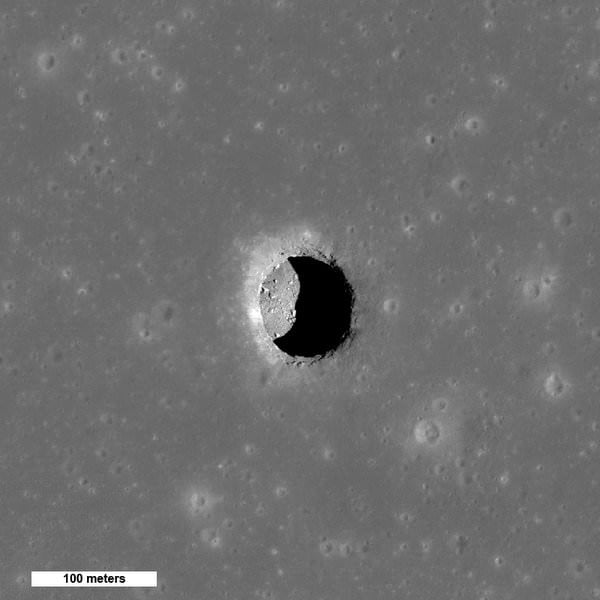For the time being, it appears NASA has set aside any ambitions to return to the Moon with human missions. But Russia may consider sending cosmonauts to the lunar surface to set up a colony using natural caves and possible volcanic tunnels as protection from the harsh lunar environment.
"If it turns out that the Moon has a number of caves that can provide some protection from radiation and meteor showers, it could be an even more interesting destination than previously thought," said veteran cosmonaut Sergei Krikalev, quoted in an
article by Reuters
.
Krikalev served on board two different space stations and flew on the space shuttle. He now leads Russia's Star City cosmonaut training center outside Moscow. He and Russian scientists discussed the possible Moon base a forum on the future of manned spaceflight.
The image above is from the Lunar Reconnaissance Orbiter showing a cave or pit found in the Sea of Tranquility. Scientists have estimated the depth of the pit at over 100 meters, and several other caves have been found with orbiting spacecraft. Lunar scientists are studying the images to determine if an extended lava tube system still exists beneath the surface.
See our article on Moon caves.
"This new discovery that the moon may be a rather porous body could significantly alter our approach to founding lunar bases," said Krikalev. "There wouldn't be any need to dig the lunar soil and build walls and ceilings. It would be enough to use an inflatable module with a hard outer shell to -- roughly speaking -- seal the caves."
Reuters quoted Russian scientist Boris Kryuchkov as saying the first such lunar colonies could be built by 2030.
[caption id="attachment_90033" align="aligncenter" width="280"]
Sergei Krikalev works aboard the Interrnational Space Station. Credit: NASA[/caption]
Krikalev has more than two years cumulative time in space His first long-duration flight to the Soviet space station Mir was in 1988, and he did back-to-back increments on Mir flight starting in May 1991 and returning to Earth in March 1992. While he was in orbit, the Soviet Union disintegrated and Mir became a Russian space station.
He became the first Russian to fly a Shuttle mission on STS-60 in February 1994. His second Shuttle flight took the Unity node to the International Space Station on STS-88 in December 1998. He was a member of the Station's Expedition 1 crew, launching in October 2000 and returning to Earth in March 2001. He launched as commander of Expedition 11 in 2005.
Source:
Reuters
 Universe Today
Universe Today
